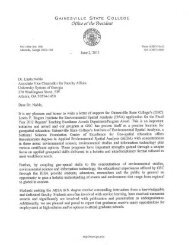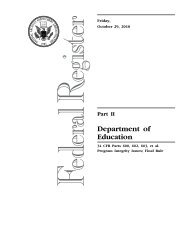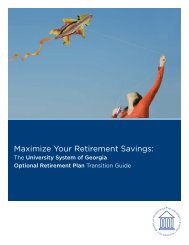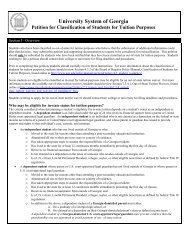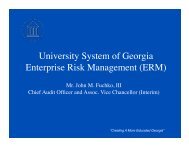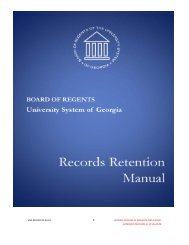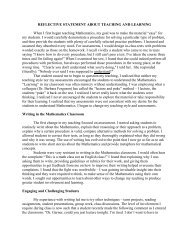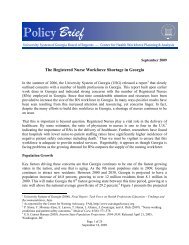75 years of transforming lives - University System of Georgia
75 years of transforming lives - University System of Georgia
75 years of transforming lives - University System of Georgia
You also want an ePaper? Increase the reach of your titles
YUMPU automatically turns print PDFs into web optimized ePapers that Google loves.
<strong>75</strong> YEARS OF TRANSFORMING LIVES<br />
Eleanor Roosevelt stands with Chancellor Steadman V. Sanford (center) and Frank Robertson Reade, President <strong>of</strong> the <strong>Georgia</strong> State<br />
Women’s College at the 1941 dedication <strong>of</strong> The Powell Library.<br />
New Deal programs enabled GSWC to expand physically from three to seven buildings. Powell Hall is still in use today at what is<br />
now Valdosta State <strong>University</strong>.<br />
The First Institutions<br />
1785, <strong>University</strong> <strong>of</strong> <strong>Georgia</strong>, Athens<br />
1828, Medical College <strong>of</strong> <strong>Georgia</strong>, Augusta<br />
1852, Gordon College, Barnesville<br />
1873, North <strong>Georgia</strong> College & State <strong>University</strong>, Dahlonega<br />
1884, Middle <strong>Georgia</strong> College, Cochran<br />
1885, <strong>Georgia</strong> Institute <strong>of</strong> Technology, Atlanta<br />
1889, <strong>Georgia</strong> College & State <strong>University</strong>, Milledgeville<br />
1890, Savannah State <strong>University</strong>, Savannah<br />
1895, Fort Valley State <strong>University</strong>, Fort Valley<br />
1903, Albany State <strong>University</strong>, Albany<br />
1906, <strong>Georgia</strong> Southern <strong>University</strong>, Statesboro<br />
1906, <strong>Georgia</strong> Southwestern State <strong>University</strong>, Americus<br />
1906, South <strong>Georgia</strong> College, Douglas<br />
1906, Valdosta State <strong>University</strong>, Valdosta<br />
1906, <strong>University</strong> <strong>of</strong> West <strong>Georgia</strong>, Carrollton<br />
1908, Abraham Baldwin Agricultural College, Tifton<br />
1913, <strong>Georgia</strong> State <strong>University</strong>, Atlanta<br />
1925, Augusta State <strong>University</strong>, Augusta
<strong>75</strong> YEARS OF TRANSFORMING LIVES<br />
MILESTONES IN THE HISTORY<br />
OF THE UNIVERSITY SYSTEM OF<br />
GEORGIA<br />
1932-2007<br />
The history and success <strong>of</strong> <strong>Georgia</strong> and its people is reflected in the state’s commitment<br />
to public higher education. This commitment goes back 222 <strong>years</strong>, with the<br />
founding <strong>of</strong> the <strong>University</strong> <strong>of</strong> <strong>Georgia</strong>.<br />
The most dramatic part <strong>of</strong> the story <strong>of</strong> public higher education in <strong>Georgia</strong> had to wait<br />
until the 1930’s, when the nation was in the grips <strong>of</strong> the Great Depression. Despite<br />
terrible economic conditions, <strong>Georgia</strong>ns, led by a young governor, Richard B. Russell<br />
Jr., made the decision to create a unified system <strong>of</strong> public colleges and universities<br />
under a single governing board.<br />
Thus was born <strong>75</strong> <strong>years</strong> ago, in a time <strong>of</strong> crisis, <strong>Georgia</strong>’s best hope and wisest<br />
investment in the future <strong>of</strong> its citizens -- the <strong>University</strong> <strong>System</strong> <strong>of</strong> <strong>Georgia</strong>.
<strong>75</strong> YEARS OF TRANSFORMING LIVES
Today, the <strong>University</strong> <strong>System</strong><br />
<strong>of</strong> <strong>Georgia</strong> provides broad,<br />
affordable access<br />
to higher education<br />
across the state through<br />
35 institutions educating<br />
260,000 students.<br />
A million more <strong>Georgia</strong>ns use the <strong>System</strong>’s continuing<br />
education programs. Farmers, businesses, libraries, public<br />
schools, and local governments -- all rely and depend<br />
upon the intellectual capital and resources <strong>of</strong> the <strong>University</strong><br />
<strong>System</strong> to solve problems, create growth opportunities<br />
and improve service to the public and customers.<br />
A recent study put the economic impact <strong>of</strong> the <strong>University</strong><br />
<strong>System</strong> on <strong>Georgia</strong>’s economy at an astounding $23.3<br />
billion annually. Each graduate from a <strong>Georgia</strong> college<br />
or university can expect to add an additional million dollars<br />
in earnings over his or her working lifetime.<br />
In short, thanks to the wisdom and vision <strong>of</strong> those <strong>Georgia</strong>ns<br />
who acted to create the <strong>University</strong> <strong>System</strong><br />
<strong>of</strong> <strong>Georgia</strong> <strong>75</strong> <strong>years</strong> ago, today, through its missions <strong>of</strong><br />
teaching, research, and service, the <strong>System</strong> touches the<br />
<strong>lives</strong> <strong>of</strong> virtually every <strong>Georgia</strong>n.<br />
This remarkable public achievement rests upon the<br />
continued commitment <strong>of</strong> successive governors<br />
and legislators to invest in <strong>Georgia</strong>’s future. It is<br />
based upon the dedication <strong>of</strong> <strong>Georgia</strong>ns who have<br />
answered the call to serve on the Board <strong>of</strong> Regents. This<br />
record is the result <strong>of</strong> the work <strong>of</strong> 11 chancellors and<br />
thousands <strong>of</strong> faculty and staff. Finally, the <strong>University</strong><br />
<strong>System</strong>’s success in serving the state has been aided by<br />
the unstinting support by local communities, businesses,<br />
and alumni <strong>of</strong> <strong>System</strong> institutions.<br />
This success was not inevitable, nor is continued success<br />
guaranteed. Throughout its <strong>75</strong>-year history, the <strong>University</strong><br />
<strong>System</strong> <strong>of</strong> <strong>Georgia</strong> has fulfilled its mission during<br />
good and hard economic times, during a period when the<br />
state’s leaders and citizens wrestled with the issue <strong>of</strong> full<br />
equality for all citizens, and through periods <strong>of</strong> dramatic<br />
growth and demands that strained resources.<br />
While the next <strong>75</strong> <strong>years</strong> cannot be predicted, the record<br />
<strong>of</strong> the past <strong>75</strong> <strong>years</strong> provides a clear outline <strong>of</strong> the future<br />
direction <strong>of</strong> the <strong>University</strong> <strong>System</strong> <strong>of</strong> <strong>Georgia</strong>. That<br />
direction is an investment in the single most powerful<br />
tool <strong>Georgia</strong>ns possess to transform individual <strong>lives</strong>,<br />
and, in turn, communities and the state. This is the<br />
chronicle <strong>of</strong> events, people, and milestones that have<br />
charted the course <strong>of</strong> higher education history, policy<br />
and access in <strong>Georgia</strong>.<br />
<strong>75</strong> YEARS OF TRANSFORMING LIVES
<strong>75</strong> YEARS OF TRANSFORMING LIVES<br />
1932-1950<br />
Birth, Conflict and Constitutional Status<br />
1932: The <strong>University</strong> <strong>System</strong> <strong>of</strong> <strong>Georgia</strong> is Born<br />
The transformation <strong>of</strong> higher education in <strong>Georgia</strong> began with the election<br />
in 1930 <strong>of</strong> Richard B. Russell Jr. as governor on a state government reform<br />
platform. As a result, the Reorganization Act <strong>of</strong> 1931 led to the creation<br />
<strong>of</strong> an 11-member Board <strong>of</strong> Regents to provide governance to the newly<br />
formed <strong>University</strong> <strong>System</strong> <strong>of</strong> <strong>Georgia</strong>. Among the Board’s first challenges<br />
were to shift governance from individual institutions to the interests <strong>of</strong> the<br />
state as a whole; to redefine the status <strong>of</strong> the <strong>University</strong> <strong>of</strong> <strong>Georgia</strong>, which<br />
had been the lone guiding force in education in the state; to assess a poorly<br />
planned core curriculum; to manage a very significant deficit; and to gain<br />
control over a disorganized and uncoordinated approach to meeting the<br />
higher education needs <strong>of</strong> all <strong>Georgia</strong>ns.<br />
The Budget Process is Unified<br />
An early accomplishment <strong>of</strong> the Board <strong>of</strong> Regents was to present a unified<br />
<strong>System</strong> budget to the governor and general assembly. The state allocated<br />
a lump sum, which was then allocated to the institutions. This was a unique<br />
and visionary structure, and it paved the way for the <strong>University</strong> <strong>System</strong> to<br />
advance higher education and promote economic development in <strong>Georgia</strong><br />
over the next <strong>75</strong> <strong>years</strong>.<br />
Political Interference Threatens Accreditation<br />
In 1941, longstanding conflicts with Gov. Eugene Talmadge threatened<br />
the autonomy <strong>of</strong> the <strong>System</strong>. The issue boiled over when the governor<br />
managed the firing <strong>of</strong> two respected employees. The result was the loss<br />
<strong>of</strong> accreditation for 10 <strong>University</strong> <strong>System</strong> schools and, for Talmadge, the<br />
loss <strong>of</strong> the governorship as voters reacted to political interference in the<br />
administration <strong>of</strong> the <strong>University</strong> <strong>System</strong>.<br />
Constitutional Status is Achieved<br />
Newly elected Governor Ellis Arnall was committed to preserving a strong<br />
<strong>University</strong> <strong>System</strong>. He was elected governor on a platform that included<br />
removing the <strong>University</strong> <strong>System</strong> from political interference (see above). In<br />
1943, Arnall secured the passage <strong>of</strong> a constitutional amendment granting<br />
the <strong>University</strong> <strong>System</strong> <strong>of</strong> <strong>Georgia</strong> constitutional status. This important<br />
event paved the way for a new era for higher education in <strong>Georgia</strong>.<br />
GI Bill Drives Post-War Enrollment Boom<br />
World War II caused a drop in enrollments, but the passing <strong>of</strong> the GI Bill<br />
sparked an enrollment boom. In 1947, the <strong>System</strong> gained 27,000 students<br />
– half <strong>of</strong> them veterans. The sudden influx <strong>of</strong> students was a driving force<br />
behind a new capital expansion program at institutions statewide, along<br />
with a greater focus on research in sciences, technology and liberal arts.<br />
Schools <strong>of</strong> Veterinary Medicine and Engineering were added at UGA and<br />
<strong>Georgia</strong> Tech, respectively.<br />
1935, Armstrong Atlantic State <strong>University</strong>, Savannah<br />
1948, Southern Polytechnic State <strong>University</strong>, Marietta<br />
First Chancellor, Charles M. Snelling (1932-1933)<br />
Chancellor Philip Weltner (1933-1935)<br />
Chancellor Steadman V. Sanford (1935-1945)<br />
Chancellor Raymond R. Paty (1946-1948)<br />
Chancellor Harmon W. Caldwell (1949-1964)
“From the 1932<br />
Board <strong>of</strong> Regents<br />
Statement <strong>of</strong> Plan”<br />
• the institutions comprising the <strong>University</strong> <strong>System</strong><br />
should no longer function as separate, independent,<br />
and unrelated entities competing with each<br />
for patronage and financial support.<br />
• the result aimed at is a correlated, harmonious<br />
and symmetrical structure free from wasteful<br />
duplication …the emphasis has been shifted<br />
from the interests <strong>of</strong> particular institutions to the<br />
interest <strong>of</strong> the State.<br />
• all problems are to be finally resolved [to]<br />
answer the question: What will best serve the<br />
educational interests <strong>of</strong> the State as a whole?<br />
<strong>75</strong> YEARS OF TRANSFORMING LIVES
<strong>75</strong> YEARS OF TRANSFORMING LIVES<br />
1950-1960<br />
The New <strong>System</strong> Settles in<br />
for Post-War Growth and Expansion<br />
Strayer Report Recommends Strategic Changes<br />
The Board <strong>of</strong> Regents commissioned a comprehensive study <strong>of</strong> the <strong>University</strong> <strong>System</strong> in the <strong>years</strong> following World War II and that report became the<br />
first plan for <strong>System</strong>-wide development since its creation. The Strayer Report strongly supported the need to subordinate the competitive ambitions<br />
<strong>of</strong> individual institutions for the sake <strong>of</strong> advancement <strong>of</strong> the entire <strong>System</strong>. It also stressed the need to prepare pr<strong>of</strong>essionally trained teachers, and<br />
to link research with graduate education. The Strayer Report also endorsed the organization <strong>of</strong> graduate schools with qualified graduate faculty<br />
members.<br />
The Strayer Report also recommended distinctive missions for certain institutions, delineated roles for the historically black institutions and addressed<br />
the roles and functions <strong>of</strong> the state’s junior colleges.<br />
Finally, the Report addressed the continuing maturation <strong>of</strong> the new <strong>University</strong> <strong>System</strong>. Recommendations were made regarding the administration and<br />
governance <strong>of</strong> the <strong>System</strong>; its budgeting, accounting and reporting needs; and its organizational structure and procedures. The most significant recommendations<br />
focused on the critical issue <strong>of</strong> financing the education <strong>of</strong> <strong>Georgia</strong>ns beyond high school as enrollments began to double and the <strong>System</strong><br />
prepared for increased student numbers through the 1960s.<br />
1958, Columbus State <strong>University</strong>, Columbus
<strong>75</strong> YEARS OF TRANSFORMING LIVES
<strong>75</strong> YEARS OF TRANSFORMING LIVES<br />
1960-1970<br />
The Color Barrier Comes Down,<br />
New Junior Colleges Provide<br />
Unprecedented Access<br />
Integration Begins<br />
The sixties marked the beginnings <strong>of</strong> integration <strong>of</strong> the <strong>University</strong> <strong>System</strong><br />
<strong>of</strong> <strong>Georgia</strong> as African Americans nationwide campaigned for equal opportunity<br />
and access. The critical date in this process was 1961, when two<br />
black students - Hamilton Holmes and Charlayne Hunter - made history<br />
and were admitted to the <strong>University</strong> <strong>of</strong> <strong>Georgia</strong>. Four other black students,<br />
who announced their intentions to apply to <strong>Georgia</strong> Tech, followed them.<br />
From this point forward, the racial and ethnic composition <strong>of</strong> students<br />
enrolled in the <strong>University</strong> <strong>System</strong> began to change to reflect the overall<br />
population <strong>of</strong> <strong>Georgia</strong>.<br />
Baby Boomers Impact <strong>System</strong> Growth<br />
The Baby Boom generation graduated from high school in the mid-60s<br />
and began to apply to <strong>Georgia</strong>’s public colleges and universities in record<br />
numbers. During this decade, the Board <strong>of</strong> Regents applied for federal<br />
funds to create additional junior colleges. Students in <strong>Georgia</strong> now had<br />
greater access to a college near their hometown and growth in enrollments<br />
<strong>System</strong>-wide tripled.<br />
1961, Coastal <strong>Georgia</strong> Community College, Brunswick<br />
1963, Dalton State College, Dalton<br />
1963, Kennesaw State <strong>University</strong>, Marietta<br />
1964, <strong>Georgia</strong> Perimeter College, Decatur<br />
1964, Gainesville State College, Gainesville<br />
1965, Clayton State <strong>University</strong>, Morrow<br />
1966, Darton College, Albany<br />
1967, Skidaway Institute <strong>of</strong> Oceanography, Savannah<br />
1968, Macon State College, Macon<br />
1968, <strong>Georgia</strong> Highlands College, Rome<br />
Chancellor George L. Simpson (1965-1979)
<strong>75</strong> YEARS OF TRANSFORMING LIVES
<strong>75</strong> YEARS OF TRANSFORMING LIVES<br />
1970-1980<br />
Academic Excellence and Equitable Funding<br />
are Major Initiatives, as Recession Hits and<br />
Desegregation Efforts Continue<br />
<strong>System</strong>atic Desegregation Proceeds<br />
The Board <strong>of</strong> Regents worked with the federal courts and the U.S. government<br />
to develop policies for the fair accommodation <strong>of</strong> all students regardless<br />
<strong>of</strong> race and for fair employment practices for <strong>System</strong> employees. The<br />
Board <strong>of</strong> Regents created a clearinghouse for new employees; a panel<br />
for investigating incidents <strong>of</strong> possible discrimination; and a statewide task<br />
force to establish goals for every institution.<br />
After 15 Years, <strong>System</strong> Desegregation Plan Earns Federal<br />
Approval<br />
The <strong>University</strong> <strong>System</strong> submitted its first plan for desegregation to the<br />
U.S. Department <strong>of</strong> Health Education and Welfare on June 11, 1973. HEW<br />
found the plan showed progress, but it was not satisfied with the basis for<br />
projections. The Board <strong>of</strong> Regents created a special committee to negotiate<br />
with HEW to satisfy its recommendations. Finally, in 1988 the U.S.<br />
District Court in Washington D.C. and the U.S. Office <strong>of</strong> Civil Rights approved<br />
the <strong>System</strong>’s plan. It was a difficult decade <strong>of</strong> work, but the l<strong>of</strong>ty<br />
goal <strong>of</strong> ensuring fair and equitable access to higher education for all was<br />
achieved.<br />
Full Formula Funding<br />
In the early 1980s, under the leadership <strong>of</strong> two governors, first George<br />
Busbee and then Joe Frank Harris, the Board <strong>of</strong> Regents, the governor’s<br />
<strong>of</strong>fice and the legislature worked together to develop significant changes in<br />
the way public higher education in <strong>Georgia</strong> was funded by the state. Aimed<br />
at achieving greater excellence for every institution, the “Formula for Excellence”<br />
was developed as an equitable way to appropriate funds based on<br />
institutional enrollment. After <strong>years</strong> <strong>of</strong> partial formula funding, the state<br />
legislature approved full funding <strong>of</strong> the formula in 1986.<br />
Special Funding Initiative Focuses on Access<br />
In 1988, the general assembly allotted $10M for a new line in the <strong>System</strong>’s<br />
budget request. The “Special Funding Initiative” was a “quality-improvement”<br />
package to provide funding outside <strong>of</strong> the formula to a number <strong>of</strong><br />
long-range <strong>System</strong> initiatives to expand access to higher education for all<br />
<strong>Georgia</strong>ns.<br />
Recession Slows Momentum<br />
In the late 80s and into the early 90s, poor statewide economic conditions<br />
resulted in significant budget reductions for the <strong>University</strong> <strong>System</strong> <strong>of</strong><br />
<strong>Georgia</strong>. The situation reached a climax in 1992 when the <strong>System</strong>’s budget<br />
was reduced by $<strong>75</strong> million. Faculty salaries, which were ranked number<br />
one by the Southern Regional Education Board (SREB) early in the 1980s<br />
suffered a set back.<br />
1973, Bainbridge College, Bainbridge<br />
1973, East <strong>Georgia</strong> College, Swainsboro<br />
1974, Atlanta Metropolitan College, Atlanta<br />
1976, Waycross College, Waycross<br />
Chancellor Vernon Crawford (1979-1985)<br />
Chancellor H. Dean Propst (1985-1993)
<strong>75</strong> YEARS OF TRANSFORMING LIVES
<strong>75</strong> YEARS OF TRANSFORMING LIVES<br />
1990-2000<br />
Accessibility, Higher Standards and Technology<br />
Mark a Decade <strong>of</strong> Dramatic Change<br />
Accent on Access<br />
In the 90s, the Board <strong>of</strong> Regents adopted a sweeping new vision statement<br />
entitled “Access to Academic Excellence for the New Millennium.”<br />
Developed with input from institution presidents, it called for <strong>Georgia</strong>’s<br />
public colleges and universities to be recognized for first-rate undergraduate<br />
education, leading-edge research and committed public service. The<br />
Board <strong>of</strong> Regents also adopted a set <strong>of</strong> 34 Guiding Principles for Action as<br />
a foundation for future policy decisions.<br />
<strong>Georgia</strong>’s HOPE Scholarship Program<br />
Since Gov. Zell Miller established the HOPE (Helping Outstanding Pupils<br />
Educationally) Scholarship Program in 1993, over $3.2 billion in HOPE<br />
funds have been awarded to more than 950,000 students attending<br />
<strong>Georgia</strong>’s public and private colleges, universities, and technical colleges.<br />
HOPE, a merit-based student-aid program for students who graduate from<br />
<strong>Georgia</strong> high schools, provides financial assistance for students who have<br />
a “B” high school grade point average and enroll in degree, diploma, and<br />
certificate programs at eligible institutions. The program is funded entirely<br />
by The <strong>Georgia</strong> Lottery for Education. As <strong>of</strong> Fall 2004 (the most recent<br />
report available), more than 76 percent <strong>of</strong> the <strong>University</strong> <strong>System</strong>’s first-time<br />
freshmen entered the <strong>System</strong> with the help <strong>of</strong> a HOPE Scholarship.<br />
GALILEO Links Libraries<br />
During this decade, the <strong>System</strong> took advantage <strong>of</strong> growing Internet technology<br />
to link the libraries at all <strong>System</strong> institutions by creating GALILEO<br />
- <strong>Georgia</strong> Library Learning Online. The resource was developed in fewer<br />
than 150 days with a $10 million budget allocation from the general assembly.<br />
The advent <strong>of</strong> GALILEO literally opened the doors to libraries around<br />
the state to all students regardless <strong>of</strong> their home institution or location - and<br />
today it is available to all <strong>Georgia</strong>ns.<br />
<strong>System</strong> Uses Internet Technology to Expand Access<br />
The Board <strong>of</strong> Regents further paved the way to use the power and scope<br />
<strong>of</strong> the Internet to attract prospective students to <strong>Georgia</strong>’s institutions by<br />
recommending the creation <strong>of</strong> a “common admission application.” Two<br />
new online <strong>System</strong> programs set the stage for greater access to college<br />
courses, admissions information, and jobs. <strong>Georgia</strong>EASY, an online admissions<br />
site, <strong>of</strong>fered admissions, career and financial information and an<br />
“easy” online admissions form; and <strong>Georgia</strong>Hire linked businesses seeking<br />
qualified employees with students searching for jobs.<br />
Raising the Bar for Admissions<br />
In 1995, the Board <strong>of</strong> Regents sought to break the cycle <strong>of</strong> low admissions<br />
expectations and inadequate college preparation by adopting the Policy<br />
Direction on Admissions. It established higher admissions requirements,<br />
which led to record high average SAT scores for first-time freshmen and<br />
the highest retention rates ever recorded in <strong>Georgia</strong>. Five <strong>years</strong> later, at<br />
the beginning <strong>of</strong> the new millennium, average SAT scores <strong>of</strong> incoming<br />
freshmen in the <strong>University</strong> <strong>System</strong> <strong>of</strong> <strong>Georgia</strong> had increased by an impressive<br />
31 points. At the same time, the Board <strong>of</strong> Regents introduced a new<br />
P-16 Policy Direction that addressed the need for “co-reform” <strong>of</strong> public education<br />
in <strong>Georgia</strong> from pre-Kindergarten through high school and aimed at<br />
ensuring that all students who graduated from <strong>Georgia</strong> high schools were<br />
prepared for postsecondary education and ready to meet the heightened<br />
standards.<br />
Prioritizing Capital Expansion<br />
During this decade, the Board <strong>of</strong> Regents took action to organize and<br />
prioritize the process for requesting funds from the General Assembly for<br />
capital expansion at its various institutions. The adoption <strong>of</strong> Capital Priorities<br />
Principles became the core <strong>of</strong> a process by which the institutions,<br />
the <strong>System</strong> and the legislature worked systematically and equitably to set<br />
priorities and fund new buildings at campuses statewide.<br />
Semester Conversion Changes Calendar<br />
In a move designed to standardize the academic calendars <strong>of</strong> the 34<br />
institutions, the Board <strong>of</strong> Regents converted the <strong>University</strong> <strong>System</strong> calendar<br />
from quarters to semesters. Though the transition went well, it would<br />
be three <strong>years</strong> before enrollments returned to normal patterns.<br />
Guaranteed Quality in Teacher Preparation<br />
As part <strong>of</strong> a move to expand and enhance its teacher preparation programs<br />
and improve teacher quality in <strong>Georgia</strong>, the Board <strong>of</strong> Regents voted<br />
to guarantee the performance <strong>of</strong> teachers who graduated from its K-12<br />
programs. This was a promise to school systems that teacher preparation<br />
programs at <strong>University</strong> <strong>System</strong> institutions were <strong>of</strong> high quality and a<br />
guarantee that the system would retrain any new graduates whose performance<br />
was not satisfactory.<br />
Chancellor Stephen R. Portch (1994-2001)
<strong>75</strong> YEARS OF TRANSFORMING LIVES
<strong>75</strong> YEARS OF TRANSFORMING LIVES<br />
2001 and beyond<br />
The New Millennium Brings Record Enrollments,<br />
National Attention for Academic Excellence<br />
and Continued Strategic Direction<br />
2001<br />
Academic Excellence is Recognized<br />
<strong>Georgia</strong> became one <strong>of</strong> a handful <strong>of</strong> states with<br />
more than one institution ranked among the top<br />
20 public national universities in the U.S. News<br />
& World Report’s annual college rankings. This<br />
national recognition underscored the fact that institutions<br />
in <strong>Georgia</strong> were academically competitive<br />
with schools throughout the nation.<br />
2003<br />
Targeting African-American Males<br />
The <strong>System</strong> launched an African-American Male<br />
Initiative to enhance access by black men to<br />
higher education and increase black male enrollment<br />
in the USG.<br />
Record Enrollments and Rising SAT<br />
Scores Signal a New Era<br />
The benefits <strong>of</strong> earlier <strong>System</strong> initiatives to<br />
strengthen admissions standards, improve accessibility,<br />
and enhance the quality <strong>of</strong> instruction<br />
at institutions statewide, plus the impact <strong>of</strong><br />
<strong>Georgia</strong>’s HOPE scholarship, resulted in record<br />
enrollments and significant increases in SAT<br />
scores <strong>of</strong> entering freshmen across the state.<br />
PRISM Working to Close the Gap in<br />
Student Achievement in Math and Science<br />
The Board <strong>of</strong> Regents received a $34.6 million,<br />
five-year grant from the National Science Foundation<br />
(NSF) to boost student achievement in<br />
science and mathematics. The grant enabled<br />
the <strong>University</strong> <strong>System</strong> to play a leading role<br />
in the Partnership for Reform in Science and<br />
Mathematics (PRISM), a collaborative statewide<br />
educational reform initiative. PRISM is helping<br />
to improve teaching and learning for more than<br />
170,000 students and more than 10,000 teachers<br />
in participating schools throughout <strong>Georgia</strong>.<br />
2003-2005<br />
The <strong>System</strong> Wields<br />
Formidable Economic Clout<br />
The economic impact <strong>of</strong> the <strong>System</strong> became evident<br />
in the middle <strong>years</strong> <strong>of</strong> the first decade <strong>of</strong> the<br />
21st century as the Board <strong>of</strong> Regents’ economic<br />
impact study determined that <strong>Georgia</strong>’s 34 public<br />
colleges and universities annually contribute<br />
$23.3 billion to the state’s economy.<br />
2004-2005<br />
<strong>System</strong> Revises Relationships with Cooperative<br />
Organizations<br />
Uncertainty regarding the exact relationship<br />
among the Board <strong>of</strong> Regents, the <strong>University</strong> <strong>of</strong><br />
<strong>Georgia</strong> and the <strong>University</strong> <strong>of</strong> <strong>Georgia</strong> Foundation<br />
caused the Board <strong>of</strong> Regents to re-evaluate and<br />
revise its own policies related to cooperative organizations.<br />
The new Board <strong>of</strong> Regents’ policy<br />
ensured that cooperative organizations such as<br />
foundations did not have authority over institutional<br />
presidents. Three outcomes <strong>of</strong> the new<br />
policy included the ending <strong>of</strong> the relationship between<br />
UGA and the UGA Foundation; a request<br />
that all <strong>System</strong>-related cooperative organizations<br />
sign new memorandums <strong>of</strong> understanding<br />
with the Board; and a change in presidential<br />
compensation so that all salaries and benefits<br />
would hereafter be paid from public funds. The<br />
policy change eliminated the practice <strong>of</strong> direct<br />
supplemental salary contributions from cooperative<br />
organizations and made the USG the first<br />
system in the nation to move presidential pay<br />
entirely to state funds.<br />
2005<br />
A New College is Born<br />
In 2005, the first new institution in the <strong>University</strong><br />
<strong>System</strong> <strong>of</strong> <strong>Georgia</strong> since 1970 was created in<br />
Gwinnett County. The Board <strong>of</strong> Regents transformed<br />
its Gwinnett <strong>University</strong> Center into <strong>Georgia</strong><br />
Gwinnett College, to serve the fastest growing<br />
region in the state.<br />
<strong>System</strong> Capital Expansion Priorities Total<br />
$3.4 billion<br />
Priorities for capital expansion totaled a record<br />
$3.4 billion in new campus facilities statewide as<br />
the <strong>System</strong> prepared to meet increasing enrollment<br />
growth and requirements for state <strong>of</strong> the<br />
art facilities. By then, the Major Capital Projects<br />
Priority List had become the primary strategic<br />
process for determining the most critical needs<br />
for facilities in the <strong>System</strong> and for securing state<br />
funding for these facilities.
Members <strong>of</strong> the 2006-2007 Board <strong>of</strong> Regents<br />
Standing, left to right: Regents Felton Jenkins, W. Mansfield Jennings Jr., Richard L. Tucker, Benjamin Tarbutton III, James R. Jolly, Donald M. Leebern Jr., Patrick S. Pittard, Willis J. Potts Jr., Hugh<br />
A. Carter, Jr., Elridge W. McMillan, J. Timothy Shelnut and Robert F. Hatcher. Seated, left to right are: Regents Julie Ewing Hunt, Wanda Yancey Rodwell, William H. Cleveland, M.D. (Vice<br />
Chair), Allan Vigil (Chair), Chancellor Erroll B. Davis Jr., and Regents Doreen Stiles Poitevint and Michael J. Coles.<br />
2006<br />
New Chancellor Brings New Focus<br />
Selected by the Board <strong>of</strong> Regents in late 2005,<br />
Erroll B. Davis Jr. became the <strong>System</strong>’s 11th<br />
chancellor in early 2006. His selection marked<br />
a first on two fronts: the first African American<br />
permanently appointed as chancellor (prior to<br />
his appointment, another African American,<br />
Corlis Cummings, served as interim chancellor),<br />
and the first chancellor from the corporate sector.<br />
Davis wasted no time in learning about the<br />
strengths and challenges in the <strong>System</strong>, visiting<br />
all 35 campuses in the first five months <strong>of</strong> his<br />
tenure and pushing forward a guaranteed tuition<br />
plan, fixing tuition for a specified period <strong>of</strong> time.<br />
The “Fixed for Four” plan allows students and<br />
families to make financial plans for college with<br />
the knowledge that tuition will not increase. The<br />
guaranteed tuition plan is helping to maintain<br />
<strong>Georgia</strong>’s historic status as an affordable state<br />
for public college attendance.<br />
Revised Planning Model Impacts Allocation<br />
<strong>of</strong> Funds for New Construction<br />
The Board <strong>of</strong> Regents endorsed a new Strategic<br />
Capital Model to enhance long-term planning<br />
for the construction <strong>of</strong> new facilities on<br />
the 35 campuses <strong>of</strong> the USG. The new model<br />
uses data for each institution’s enrollment,<br />
anticipated growth, square footage, the age and<br />
condition <strong>of</strong> current facilities, and the Board <strong>of</strong><br />
Regent’s strategic priorities.<br />
It enables the <strong>System</strong> to be more responsive<br />
and dynamic in allocating capital construction<br />
funds to the 35 campuses <strong>of</strong> the USG.<br />
Educating More <strong>Georgia</strong>ns to<br />
Higher Levels<br />
Chancellor Davis has set for the <strong>University</strong><br />
<strong>System</strong> a goal <strong>of</strong> educating more <strong>Georgia</strong>ns to<br />
higher levels than in the past. To achieve this<br />
goal, the Board <strong>of</strong> Regents are in the process<br />
<strong>of</strong> creating a new Strategic Plan to guide policy<br />
and actions that address the key challenges <strong>of</strong><br />
access, affordability, and accountability. In this<br />
respect, the mission and role for the Board <strong>of</strong><br />
Regents and the <strong>University</strong> <strong>System</strong> <strong>of</strong> <strong>Georgia</strong><br />
as envisioned by <strong>Georgia</strong>’s leaders in 1931 has<br />
not fundamentally changed. The <strong>System</strong> continues<br />
to serve as the primary vehicle driving the<br />
state’s growth and vitality through teaching, research<br />
and service.<br />
2005, <strong>Georgia</strong> Gwinnett College,<br />
Lawrenceville<br />
Chancellor Thomas C. Meredith<br />
(2002-2005)<br />
Chancellor Erroll B. Davis Jr.,<br />
(2006- ), Eleventh Chancellor<br />
<strong>of</strong> the <strong>University</strong> <strong>System</strong> <strong>of</strong> <strong>Georgia</strong><br />
<strong>75</strong> YEARS OF TRANSFORMING LIVES
USG Alumni Lives Transformed<br />
James M. Baker III<br />
Clayton State <strong>University</strong>, 19<strong>75</strong><br />
President, Chaseland Corp. and Baker & Lassiter<br />
John Wesley Blassingame<br />
Fort Valley State <strong>University</strong>, 1960<br />
Pr<strong>of</strong>essor, author, playwright, speaker<br />
Maxine Burton<br />
Gainesville State College, 1969-1970<br />
<strong>University</strong> <strong>of</strong> <strong>Georgia</strong>, 1972 & 1978.<br />
Founder, President burton + BURTON<br />
James Earl Carter<br />
<strong>Georgia</strong> Southwestern State <strong>University</strong>, 1941<br />
<strong>Georgia</strong> Institute <strong>of</strong> Technology, 1943<br />
Governor, U.S. President, Nobel Prize Laureate, 2002<br />
Dr. Emily Craig<br />
Medical College <strong>of</strong> <strong>Georgia</strong>, 1976<br />
Author, state forensic anthropologist, Kentucky<br />
Gregory Daniels<br />
Albany State <strong>University</strong>, 1974<br />
Senior Vice President, U.S. Manufacturing<br />
Nissan North America, Inc.<br />
Maj. Gen. Walter E. Gaskin, United<br />
States Marine Corps<br />
Savannah State <strong>University</strong>, 1974<br />
Commanding general, U.S. Marine Corps<br />
Second Division<br />
Charlayne Hunter Gault<br />
<strong>University</strong> <strong>of</strong> <strong>Georgia</strong>, 1963<br />
Newspaper, television journalist, author<br />
Dr. J. Phillip Gingrey, Jr.<br />
Medical College <strong>of</strong> <strong>Georgia</strong>, 1969<br />
Physician, U.S. Congressman<br />
Richard H. Glanton<br />
<strong>University</strong> <strong>of</strong> West <strong>Georgia</strong>, 1968<br />
Attorney, service in Nixon and Ford administrations,<br />
United Airlines, Conrail, deputy counsel, Gov. <strong>of</strong><br />
Pennsylvania<br />
Brig. Gen. David L. Grange<br />
North <strong>Georgia</strong> College & State <strong>University</strong>, 1970<br />
President, Robert R. McCormick Tribune Foundation,<br />
CNN military analyst<br />
John Huey<br />
<strong>University</strong> <strong>of</strong> <strong>Georgia</strong>, 1970<br />
Editor-in-Chief, TIME Inc<br />
Terry Kay<br />
<strong>University</strong> <strong>of</strong> West <strong>Georgia</strong>, 1957<br />
Author, screenwriter, Emmy award winner<br />
Richard H. Lenny<br />
<strong>Georgia</strong> State <strong>University</strong>, 1974<br />
Chairman/CEO/President, The Hershey Company<br />
Kenneth D. Lewis<br />
<strong>Georgia</strong> State <strong>University</strong>, 1969<br />
Chairman/CEO/President, Bank <strong>of</strong> America Corp<br />
Harold E. Linnenkohl<br />
Southern Polytechnic State <strong>University</strong>, 1968<br />
Commissioner, <strong>Georgia</strong> Department <strong>of</strong> Transportation
USG Alumni Lives Transformed<br />
Percy A. Mack Jr.<br />
Savannah State <strong>University</strong>, 1971<br />
<strong>University</strong> <strong>of</strong> <strong>Georgia</strong>, 1972<br />
<strong>Georgia</strong> State <strong>University</strong>, 1998, 2000<br />
Superintendent <strong>of</strong> Dayton (OH) Public Schools,<br />
National Alliance <strong>of</strong> Black School Educators 2006<br />
Superintendent <strong>of</strong> the Year<br />
Sheree Mitchell<br />
Columbus State <strong>University</strong>, 19<strong>75</strong><br />
Founder, Growing Room Child Development Centers<br />
National Small Businessperson <strong>of</strong> the Year, 2004<br />
J. Tom Morgan<br />
Darton College, 19<strong>75</strong><br />
<strong>University</strong> <strong>of</strong> <strong>Georgia</strong>, 1977, 1980<br />
Attorney, former DeKalb County District Attorney,<br />
national expert on crimes against children<br />
Dr. Kary B. Mullis<br />
<strong>Georgia</strong> Instiute <strong>of</strong> Technology, 1966<br />
Nobel Laureate for developing the polymerase chain<br />
reaction (PCR), which revolutionized molecular biology,<br />
medicine and many other related scientific fields.<br />
Larry Nelson<br />
Kennesaw State <strong>University</strong>, 1971<br />
Pr<strong>of</strong>essional golfer,<br />
inducted World Golf Hall <strong>of</strong> Fame, 1986<br />
Flannery O’Connor<br />
<strong>Georgia</strong> College & State <strong>University</strong>, 1945<br />
author<br />
Gene Patterson<br />
North <strong>Georgia</strong> College & State <strong>University</strong>, 1942<br />
Editor, The Atlanta Constitution,<br />
Pulitzer Prize winner, 1967<br />
George I. “Sonny” Perdue<br />
<strong>University</strong> <strong>of</strong> <strong>Georgia</strong>, 1971<br />
Governor<br />
David M. Ratcliffe<br />
Valdosta State <strong>University</strong>, 1970<br />
Chairman/CEO, Southern Company<br />
Glenn Richardson<br />
<strong>Georgia</strong> State <strong>University</strong>, 1981, 1984<br />
Speaker, <strong>Georgia</strong> House <strong>of</strong> Representatives<br />
Martha Barrs Robertson<br />
Valdosta State <strong>University</strong>, 1953<br />
Vice President, the Coca-Cola Company (retired)<br />
VSU Distinguished Alumnus, 1986<br />
Theresa A. Rodgers<br />
Macon State College, 1983<br />
<strong>Georgia</strong>’s first woman U.S. Marshal<br />
George T. Smith<br />
Abraham Baldwin Agricultural College, 1940<br />
Only <strong>Georgia</strong>n to be elected to all three branches <strong>of</strong> state government:<br />
<strong>Georgia</strong> House, Lt. Governor, <strong>Georgia</strong> Supreme Court<br />
James D. Yancey<br />
Columbus State <strong>University</strong>, 1964<br />
Chairman, Synovus Financial Corp. (retired)<br />
Member, Board <strong>of</strong> Regents, 1999-2006
<strong>75</strong> YEARS OF TRANSFORMING LIVES<br />
BY THE NUMBERS<br />
The <strong>University</strong> <strong>System</strong> <strong>of</strong> <strong>Georgia</strong><br />
was created to provide a strong,<br />
unified, academically excellent<br />
system <strong>of</strong> public higher education<br />
for <strong>Georgia</strong>ns. This mission has<br />
been fulfilled for <strong>75</strong> <strong>years</strong>.<br />
The future challenge is to educate<br />
more <strong>Georgia</strong>ns than in the past to<br />
even higher levels.<br />
<strong>Georgia</strong>’s wise and continued<br />
investment in its university system<br />
will ensure this challenge will be met.<br />
1930<br />
State population: 2,908,506<br />
Enrollment in public colleges in <strong>Georgia</strong>: approximately 6,000 students<br />
1940<br />
State Population: 3,123,723<br />
USG enrollment: 18,736<br />
1950<br />
State population: 3,444,478<br />
USG enrollment: 18,417<br />
1960<br />
State Population: 3,943,116<br />
USG enrollment: 30,686<br />
1970<br />
State population: 4,589,5<strong>75</strong><br />
USG enrollment: 96,321<br />
1980<br />
State population: 5,463,105<br />
USG enrollment: 126,807<br />
1990<br />
State population: 6,478,149<br />
USG enrollment: 180,447<br />
2000<br />
State population: 8,186,453<br />
USG enrollment: 205,878<br />
2006<br />
State population (estimated): 9,363,941<br />
USG enrollment: 260,000
Published by Office <strong>of</strong> Media and Publications | Board <strong>of</strong> Regents | 270 Washington Street, S.W. | Atlanta, <strong>Georgia</strong> 30334 | (404) 656-2250



